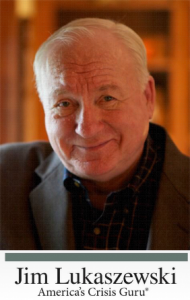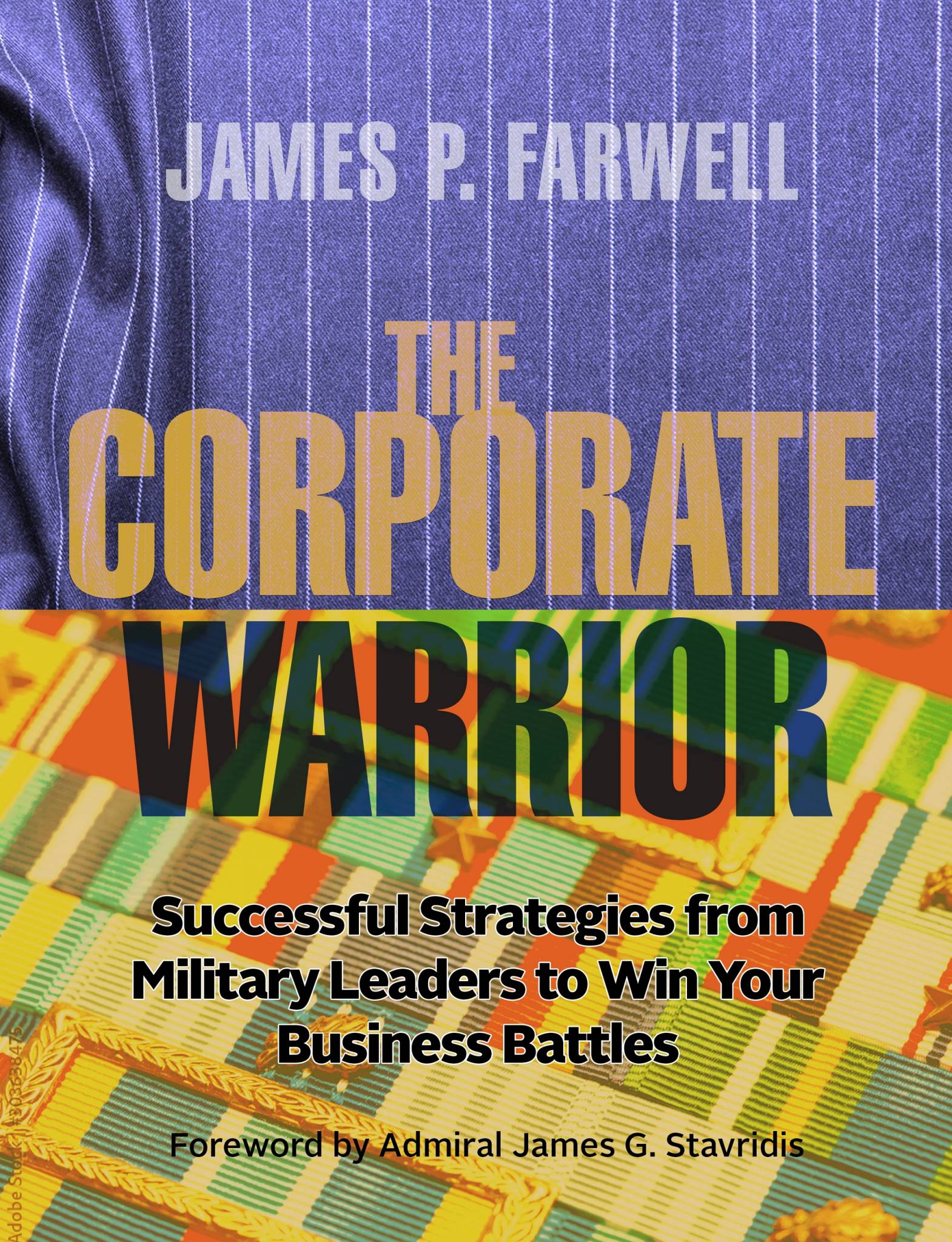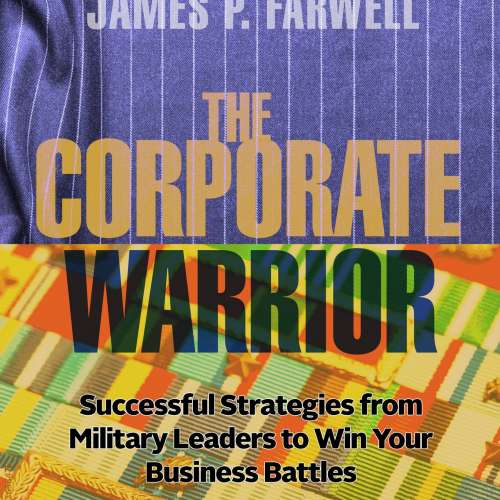Description
FREE CHAPTER
WHAT OBSTACLES MUST YOU
OVERCOME?
From
THE CORPORATE WARRIOR:
Successful Strategies from
Military Leaders to Win Your Business Battles
by James P. Farwell
PRINT BOOK AND EBOOK NOW AVAILABLE!
Military Warriors Offer Business Leaders Actionable Strategies for Breakthrough Success on Your Fields of Battle!
You make critical strategic and leadership decisions in real time. You need clear, concise, timely information to meet goals, improve performance, and increase profitability. With threats, technology, and competition changing the game at cyber speed, you, as a corporate leader and strategist, are constantly faced with life-or-death business challenges.
Leading international military strategists who have learned survival lessons the hard way on the front lines and yet emerged victoriously can be your guides to winning strategies.
The Corporate Warrior is a practical book loaded with direct, actionable strategies. Thanks to James Farwell’s direct relationships and experiences working with these well-known military leaders, you will learn powerful strategies and tactics to enable your enterprise to confront insurmountable challenges and conquer competition while winning valuable customer recognition and support for your brand!
Includes a Foreword by Admiral James (“Jim”) George Stavridis, plus thoughts on THE CORPORATE WARRIOR from Jim Lukaszewski, America’s Crisis Guru®.
===========================================================
“This fascinating book takes us behind the scenes to see what corporate heads and business owners have done right, done wrong, and shows how today’s leaders can use the advice to successfully course-correct. I recommend this book as well to former military men like myself. When our initial careers wind down, many of us will serve on corporate boards, or work directly inside corporations, as I now do. For us, these examples serve as vivid reminders of what we, too, can take away from each other’s military tactics and strategies.” – Admiral James (“Jim”) George Stavridis (Ret), Supreme Allied Commander – Europe (SACEUR), retired four-star United States Navy admiral, and bestselling author is currently an operating executive with the Carlyle Group and chair of the board of counselors at McLarty Associates.
“Every business leader should put The Corporate Warrior at the top of their reading list. It is an incredibly insightful and thought-provoking work. Especially as we think about marketing and managing for the future.” – John P. Kotts, CEO, Kotts Capital
“Informative, entertaining, a must-read for every executive at all levels.” – Boysie Bollinger, Chairman and CEO, Bollinger Enterprises, Bollinger Shipyards, Inc.
2022, 304 pages including full index.
Print – ISBN: 978-1-944480-74-5
EPUB – 978–1-944480-75-2
WEB PDF – 978-1-944480-76-9
Table of Contents
Table of Contents
WHAT YOUR COLLEAGUES ARE SAYING ABOUT THE CORPORATE WARRIOR iii
DEDICATION vi
FOREWORD By Admiral James (“Jim”) George Stavridis vii
Jim Lukaszewski, America’s Crisis Guru® on The Corporate Warrior xi
PREFACE xiii
CONTENTS xix
CHAPTER ONE UNDERSTAND THE GLOBAL COMPETITIVE MARKETPLACE 1
The Theory of Special Operations Teaches Lessons 2
How Do These Precepts Affect Target Audiences? 10
Apple Surges Us Into a New World 13
Nike Summons the Hero Within Us 14
Saks Strikes Back at the Evil Empire 15
Starbucks Offers a World Apart We Can Enjoy at Home 17
Discussion Questions 19
CHAPTER TWO DEFINE SUCCESS 21
Acquiring the Knowledge 23
Lessons from Iraq and Afghanistan 26
The Drug Wars and Centers of Gravity 28
Mexico’s Challenge 29
Lessons for Executives 31
The Hope Diamond of Razor Blades 31
Gillette Pays for Its Hubris 33
Innocent and the Three College Guys 33
The Diaper Wars 35
Values and Centers of Gravity 35
Discussion Questions 37
CHAPTER THREE WHAT OBSTACLES MUST YOU OVERCOME? 39
Malaysia 58
A Commercial Parallel 59
Discussion Questions 64
CHAPTER FOUR UNDERSTAND YOUR TARGET AUDIENCE 65
Nike Gets It 66
Daisy’s Explosive Impact 69
Corporate Home Runs 70
Vital Precepts 71
Discussion Questions 75
CHAPTER FIVE ELEMENTS OF STRATEGY 77
Grand Strategy 78
An Israeli View 82
Strategy and Industry 82
Strategic Positioning 86
Nothing Good Comes Easy 87
A Presidential Comparison 87
Reason Persuades, Emotion Motivates 88
What About Humor? 91
Quirky Works 93
1984: Go with Your Gut Instinct 95
Perceptions of Status Motivate 96
Levis are Hip 97
Tailor Your Strategy to the Culture 99
Discussion Questions 101
CHAPTER SIX CRITICAL ELEMENTS OF A STRATEGIC COMMUNICATION PLAN 103
Discussion Questions 126
CHAPTER SEVEN DEVELOPING YOUR STORY AND NARRATIVE 127
Emotional Intelligence 129
Seizing the Moral High Ground 131
Deeds Matter as Much as Words 132
Whose Narratives and Stories Are Emotionally Resonant? 133
Dove’s Self-Esteem Project 137
Discussion Questions 143
CHAPTER EIGHT OVERCOMING OBSTACLES TO YOUR SUCCESS 145
Coca-Cola 153
The Pepsi Challenge 156
EAGLE CLAW 157
The Challenger Disaster 159
It Happens to Companies Too 160
Social Media 168
Discussion Questions 177
CHAPTER NINE HOW VITAL IS STRATEGIC COMMUNICATION TO CRISIS MANAGEMENT? 179
A Military Example: Abu Ghraib 179
Tylenol 185
Union Carbide 187
Boeing 191
Starbucks 194
Exxon Valdez 196
Key Lessons About Crisis Management 197
Discussion Questions 216
CHAPTER TEN CYBERSECURITY RESILIENCE 217
Defending Against Attacks 220
Looking at Industry 223
The Broader Implications 226
Strategic Communication to Protect Companies 228
Infectious Disease Pandemics 234
Discussion Questions 239
CONCLUSION 241
INDEX 249
ACKNOWLEDGMENTS 267
CREDITS 276
ABOUT THE AUTHOR 277
ABOUT ROTHSTEIN PUBLISHING 280
FOREWORD By Admiral James (“Jim”) George Stavridis
FOREWORD
By Admiral James (“Jim”) George Stavridis
Like James Farwell, I have always held that leaders in the military and the business world have much in common. Both must clash with or compete against adversaries and emerge victoriously. Like war and the world of global politics, business is an ongoing, tough-minded competition.
As a retired Admiral who had the honor of serving as Supreme Allied Commander – Europe and today an executive with The Carlyle Group, I know from personal experience and observation that executives and entrepreneurs can learn a great deal from each other.
Were he with us today, the great Sun Tzu would almost certainly agree. Among the sage advice he gives military commanders in his iconic The Art of War is this: strategy without tactics is the slowest route to victory. Tactics without strategy are the noise before defeat.
This book lays out insightful strategies and tactics that apply to the military and industry.
James has interviewed dozens of military leaders – generals, admirals, colonels, flag officers – and CEOS of various businesses, public and private. In relaying their advice from the frontlines of military strategies and practices, he provides vital information on how executives can overtake and beat competitors in challenging marketplaces.
This fascinating book takes us behind the scenes to see what corporate heads and business owners have done right, done wrong, and shows how today’s leaders can use the advice to successfully course-correct. Case studies range from footwear endorsed by prominent athletes to a brand-new type of razor for men and everything in between. It’s informative, and the lively writing makes a great read.
I recommend this book as well to former military men like myself. When our initial careers wind down, many of us will serve on corporate boards, or work directly inside corporations, as I now do. For us, these examples serve as vivid reminders of what we, too, can take away from each other’s military tactics and strategies.
Sun Tzu also wrote: If you know the enemy and know yourself, you need not fear the result of a hundred battles. If you know yourself but not the enemy, for every victory gained, you will also suffer a defeat. If you know neither the enemy nor yourself, you will succumb in every battle.”
Exchange the word “enemy” for “competition,” follow James’ logic and examples, and you will see Sun Tzu’s timeless advice in modern dress. Know your competition and know who you are and how what you offer differs, and you have a solid foundation for growth and success. Recognize that strategy is an art as much as a science. Provide strong moral leadership, and root your company in strong, positive values including integrity, loyalty, excellence, hard work, and above all, a commitment to improving the lives of others.
If you concentrate only on what you offer and not the competition’s pluses and minuses, you may survive for a while, but you will not grow. If you’re blind to who and what your brand and your company really are, who your competition is, and what your audiences genuinely want, the battle is already lost – kind of like those dinosaurs of old who kept running even after a tiger gnawed on one of their legs. By the time they tried to shake the aggressor off, it was too late. They went down with a thud.
James shows you companies that mirror all three of these aspects: they knew, they grew. But, they had a blind spot for the competition; they stagnated. They didn’t do their due diligence and were somewhat delusional about their strengths – they died a slow death.
If you heed the advice here, you might avoid the fate of the dinosaurs and evolve into the most successful version of yourself. Now hop to it!
Admiral James (“Jim”) George Stavridis (Ret), Supreme Allied Commander – Europe (SACEUR), a retired four-star United States Navy admiral, and bestselling author, is currently an operating executive with the Carlyle Group and chair of the board of counselors at McLarty Associates. His novel, “2034: A Novel of the Next World War,” was published in March 2021. https://admiralstav.com/
Jim Lukaszewski, America’s Crisis Guru® on The Corporate Warrior
Jim Lukaszewski, America’s Crisis Guru® on The Corporate Warrior
I believe you will find this unusual, in that it’s customary to ask the author to identify the target audiences of the book in which you are about to be a guest author; James Farwell’s answer was powerfully refreshing. When I suggested that maybe it’s a leadership book, he responded quickly and decisively that this is a book for those who may already be guiding leaders or managers and who, themselves, expect to be leaders of tomorrow.
If this is you, you are at the right place, and you are holding in your hands a career-building resource that covers many of the most urgent issues that you, as a future senior manager/leader, will encounter on your journey. Farwell wisely observed that today’s leaders have more than likely already decided how to handle various critical organizational situations. Changing their minds and altering their opinions is harder and harder for them as they reach the highest levels of management and leadership.
Here’s the proof: First, there are an extraordinary number of examples of successful and missed opportunities, of surprise successes and of some real boneheaded mistakes. This book provides up-and-coming leaders and managers with a variety of useful and thoughtful examples that enlighten and enhance the importance of whatever advice is suggested or recommended.
This is also a very sensible business book which will remind you through its dozens and dozens of examples of the available options to resolve crucial situations powerfully or poorly, sensibly, or stupidly. The wisdom of this approach is to empower effective advice by providing options for decision-making from which a leader may consider changing a strategy that can powerfully alter outcomes. And, of course, as an influencer, you stand ready to absorb the blame if shifted in your direction or be a silent hero as the leader takes responsibility for success.
My 40+ year career has largely been devoted to helping leaders and their organizations prepare for, respond to, and recover from crises. I typically arrive on the scene after-the-fact. One of the larger lessons, perhaps the largest I have learned, is the propensity for leaders and senior managers to intentionally make, even repeat, bad choices.
Some of the examples chosen in this book present poor decisions made intentionally that go unchallenged, sometimes as a result of the increasing speed required to make effective competitive decisions. Too often, decisions get made simply because a senior manager or leader has the power to make them. This book advances your experience through understanding the tension, stress and urgency that causes errors and misjudgments of critical situations.
Is this a book about leaders and leadership, certainly!
Is this a book about strategy, definitely!
This book is really focused on you, and on helping you advance your career in significant ways. The main advice Farwell offers is that you will advance more significantly and rapidly throughout your career if you focus first on being an increasingly trusted strategic advisor. Be a trust builder and others will trust you more rapidly in return.
James E. Lukaszewski
ABC, Fellow IABC, APR, Fellow PRSA,
BEPS Emeritus
Chairman
The Lukaszewski Group
Minneapolis, Minnesota
https://www.e911.com/
PREFACE
If you’re a middle or upper-middle-level executive, or a business school student, The Corporate Warrior is for you. It’s about leadership and lays out specifically how to think through and execute strategic plans for marketing and sales, crisis communication, as well as dealing with social media and the cyberworld.
Success in strategic planning – whether corporate or military – starts with leadership that understands the competitive playing field, defines success, and forges winning strategies, plans, operations, and tactics. But the top leadership is only as strong as people like yourself, who provide ideas, plans, and critical analysis, and then execute strategic thinking.
Modern business faces challenges that parallel the battles waged by the military. The military’s precepts translate to industry. I’ve advised C-suite CEOs, CFOs, and COOs, from major multi-national companies such as RJR Nabisco, Philip Morris, Freeport-McMoran, Monsanto, Entergy Corporation, Microsoft, Boeing, and Monsanto, among others.
The Corporate Warrior draws upon interviews with dozens of retired generals, admirals, and senior officers, along with Pentagon and intelligence officials who moved to the business world and applied their military expertise to industry.
I’ve worked closely with senior officers in the US and United Kingdom for twenty years. People often ask me my assessment of them. I can summarize them collectively in two words: awe-inspiring. They’re intelligent, dynamic, disciplined, focused, and result-oriented. They exude an aura of leadership. They respond to imaginative, innovative thinking from the people who rank below them on the ladder of authority.
This book draws on my own experience of two decades as a strategic advisor to the US Department of Defense, the US Special Operations Command, the US Strategic Command, major corporations, candidates for public office, and a cybersecurity attorney.
The Corporate Warrior uses some examples drawn from Information Warfare (Quantico: Marine Corps University Press, 2020) – which I wrote for commanders and operators (ordinary soldiers) – to provide comparisons to industry approaches. This book is my fifth as an author or co-author analyzing strategic communication and information warfare.
Chapter One: Understand the Global Competitive Marketplace describes how the military and national security leaders see the world as a marketplace for the global competition of ideas. It’s the world in which you must compete. In today’s world, you must use every channel of communication, from social media to personal engagement to traditional media, as you compete to influence target audiences and shape behavior. The world is changing rapidly. Approaches to strategy and communication need to stay ahead of the curve. But understanding the arena in which competition occurs is vital if you’re going to prevail.
Chapter Two: Define Success explains the notion of winning. In both the military and industry, successful strategic communication starts with defining success. What constitutes winning? How do you measure that? The military thinks about achieving particular conditions that define an “end-state,” the situation on the ground once operations conclude. The failure to specify that clearly in Iraq until 2007 and for nearly twenty years in Afghanistan produced headaches in Iraq and defeat in Afghanistan. Victories achieved in the 1991 Gulf War or taking down Panama President Manuel Antonio Noriega stemmed from clarity of vision. The key for you, whether starting your own business or joining a larger enterprise, is to understand what success requires.
Chapter Three: Identify Obstacles requires that you understand the society, culture, history, leadership, and values of any target audience. The military contends with hostile adversaries, unfamiliar cultures, target populations focused on local agendas. Our actions may or may not interest them. Different societies embrace different values. Remember the word values; it’s become a cliché in US politics. But value-driven companies and governments focused on improving lives are more likely to succeed. In this chapter, corporate examples illustrate the precept. For example, after drowning in red tape, IBM reincarnated its identity. Apple urged customers to think differently. Nike built success around a narrative that you can improve your life through sports. Starbucks understood the power of connections in a culture in which many people feel isolated.
Chapter Four: Understand Your Target Audience examines how you target audiences. The military faces a more complex challenge: you can change consumer tastes, but you can rarely change the fixed political beliefs or convictions of military target audiences. You need to understand your target audience. What do they think about what interests you? What do keywords mean to different people? What language do you use to communicate ideas?
Chapter Five: Elements of Strategy analyzes strategy and tactics. Strategy has been notoriously difficult to define. The military and industry face similar challenges, although they may surmount them differently. The US military operates at three confluent levels: strategic, operational, tactical. Strategy in the West exists at a grand and a tactical level. Other nations employ different terms. Russia doesn’t embrace the language “grand strategy” – it employs a notion of “national strategy” that has distinct nuances. Industry has seen its share of grand strategic successes. In this chapter, we’ll look at Nike, IBM, Apple, and Starbucks. Their marketing epitomizes strategic excellence.
Chapter Six: Critical Elements of a Strategic Communications Plan looks at how story and narrative play in strategy. People make sense of events through the roles that people play in shaping events and outcomes. The story sets forth what people do. The narrative explains why actors take their actions. Anything you do – sell a service, market a product, run for office, defeat a military adversary, win over target audiences – involves a story. You get nowhere unless you understand who you want to talk to and what you want from them. Target audiences make sense of all this, of what people do, why, and how, through stories. Actors, action, events – we watch or listen to these to understand.
Chapter Seven: Developing Your Story and Narrative explains how you apply strategy and tactics, story, and narrative to get results. There is no formula. You tailor actions to each situation. Achieving objectives entails complicated, nuanced steps. You distinguish among the indispensable, influential, and inessential players. You divide responsibilities, secure buy-in from stakeholders, instill accountability and responsibility, and pose the right questions to the right stakeholders at the right time.
Chapter Eight: Overcoming Obstacles to Your Success analyzes how obstacles are part of life. We can’t wish them away. In warfare and the commercial world, you must identify them and be smart and practical in devising communication and other strategies to overcome them. And I assert: Americans are geniuses at believing that bad people are stupid and do the wrong thing. Looked at in terms of their goals, they are often smart and do the right thing. Never underestimate an obstacle. The seemingly small ones may be what kills you. That’s why Mike Bloomberg’s insight that you “win the tough battles by inches” is so powerful.
Chapter Nine: How Strategic Communication is Vital to Crisis Management dissects crisis communication. Iraq offers an excellent example of how the military dealt with the Abu Ghraib scandal. You can learn a lot from Johnson & Johnson’s handling of the Tylenol scare, Union Carbide’s troubled response to the Bhopal disaster, Boeing’s fiasco over its Supermax 737 jets, and how Starbucks addressed ethnic sensitivities.
Chapter Ten: Cybersecurity Resilience describes how cybersecurity and cyber issues affect reputation, business interruption, shareholder value, and liability. You cannot eliminate cyber threats. You can manage them. Cybersecurity is a pressing issue. People think it’s just about technology. Wrong! Your Chief Information Security Officer (CISO) is too often put in the IT box. He or she must be part of management, not IT operation. Cyber is a very difficult, complex field. Strategic communication is vital, and how you employ it may determine whether you keep your reputation, your business operations functioning, your stock prices high, and yourself insulated from legal liability. Once lost, these assets are hard to recover.
Strategic planning and communication embrace science. But as much as anything, it’s art. Whether you are military or industry, you can learn from one another. You can increase profits and market share by drawing lessons on how successful leaders forge and execute strategies, operations, plans, and tactics.
A lifelong passion for campaigns and understanding strategic communication inspired me to write this book. Information binds us and our communities in a world characterized by connectivity and networks. It is a principal way that we define our identity, describe our ideas, and connect with one another. The ends, ways, and means that govern strategies for making such connections have long fascinated me. I hope this book sheds light on that dynamic, informing as well as entertaining you.

James P. Farwell
New Orleans, Louisiana
January 2022
Excerpts from THE CORPORATE WARRIOR
Lessons for Executives
The stakes for you as an executive don’t usually involve life or death. But sometimes they may. As Retired British Army Colonel Stephen Padgett OBE, former commander of British troops in Afghanistan and Britain’s defense attaché there, and today the CEO of Britain’s National Horseracing College that educates thoroughbred horse trainers, jockeys, and support staff, points out, “a horse weighs half a ton, and when you’re a jockey riding in a crowded field of twenty horses, you’re well aware of the genuine risk to life and limb.”
You must maintain a grip on your centers of gravity. Apple’s center of gravity rests on its ability to project the image of a cutting-edge company that opens new vistas of knowledge. Nike’s center of gravity is athletes who agree sports improve their lives. Nike’s inspiring narrative – I come back to Nike throughout this book as I find its approach is so outstanding – appeals to our innate desire to excel.
Harry’s Razors illustrates how innovative thinking that zeroes in on a well-defined goal of success can pay off.
The Hope Diamond of Razor Blades
Harry’s Razor’s success required the same imagination and disciplined thinking that military combat demands. Harry’s did not need to corner the market in razor blades. It just needed to get its share. It devised an ingenious strategic communication plan. Let’s take a look.
“This thing might just be the Hope Diamond of razors,” Gentlemen’s Quarterly trumpeted in reviewing Harry’s Razors “Winston” razor blade. This article compared the startup company that makes razor blades for men to the famous jeweler whose diamonds have adorned stars like Dame Helen Mirren, Julie Andrews, Madonna, and Natalie Portman.
One might wonder about the comparison. Reportedly, the Hope Diamond carried a curse from Louis XIV to an American heiress. The curse holds that whoever owns the 45-carat diamond is ill-fated for life. Weeks after a French merchant sold it to the Sun King, a pack of wild dogs mauled the merchant to death. King George IV got hold of it and wound up with a mountain of debt that forced him to sell the diamond. Suicide, murder, and bankruptcy afflicted subsequent owners.
Bold and irreverent, Harry’s Razors proudly quoted GQ on its website. Founded in 2012, owners Andy Katz-Mayfield and Jeff Raider believed they could take on Gillette, the razor blade market’s 800-pound gorilla in the $2.4 billion shaving industry. They launched a bold subscription service that garnered 100,000 email addresses within a week. Harry’s Razors had innovative marketing that stressed personal service and a top-tier product. It made consumers who wanted a personalized, tailored product its center of gravity. Entering the market, Harry’s moved fast and decisively, catching Gillette off-guard.
Customers define its marketing strategy. The company continuously interacts with them. As a customer myself, I can attest to the customer service and blades. Harry’s Razors delivers. By 2016, it had attracted two million customers and expanded its product line with Flamingo, a women’s skincare brand. Harry’s Razors and competitors like the Dollar Shave Club, another subscription service, disrupted the industry and created a new business model for men’s grooming. They developed a strategy and pulled out the stops.
Gillette Pays for Its Hubris
Gillette dismissed the competition. The big dog depended upon long-term brand loyalty and a conviction that it owned the best product. I was like a lot of folks who junked the brand. Its razors were expensive. Gillette was a walking excuse for growing a beard. I came across a Harry’s Razors ad, took a chance. and found them as good Gillette but less expensive. I loved the personal service.
Writing in Inc, John Warrillow echoed my feelings in a “Dear Gillette” Op-Ed: “With no other solution, we buy the same blades every few weeks because we have better things to worry about. Until one day something shocks us back to reality and the insanity of paying $45 for blades.” Gillette’s form letter reply was babble. Warrillow said it well. Gillette’s had a weak rationale for its product. Harry’s Razors and Dollar Shave Club exploited that and won big.
Gillette had the resources to add muscle to its marketing. But Harry’s had bold leaders who seized – and continue to build – market share before the behemoth could stop them. Harry’s had a clear-eyed view of success and zeroed in on doing whatever it took. It succeeded.
WHAT OBSTACLES MUST YOU OVERCOME?
You – and the military – need to know the competition and the strategic area in which competition takes place. Once you’ve defined what success means, you will need to identify the obstacles to your success. The general precept is “know your enemy” – or competitor. That means do your homework, which includes cogent target audience analysis.
Here are essential considerations.
- Identify your competitor or enemy.
Identifying the enemy can challenge the military commanders. Identifying Taliban members in Afghanistan, Al Qaeda in Iraq, and the Viet Cong or North Vietnamese during the Vietnam war often proved tricky, as they blended in with the population. Enemies often avoid showing themselves. You need dependable ways to identify enemies. Intelligence collection is vital. Understanding the enemy can prove tricky. What motivates, inspires, threatens, or frightens an enemy? What coalitions does the enemy belong to? What is the nature and composition of such alliances? Understanding these considerations enables you to identify vulnerabilities.
As an executive, you can skip over this obstacle. You can easily identify competition. Less obvious, says David Patterson, is which competitor offers the best opportunity to compete against and win. If you design a new shirt, is Brooks Brothers, Saks Fifth Avenue, or a regional brand the easiest target to raid for market share? UNTICKit’s Wrinkle-Free Douro Shirt and the men’s clothing subscription service Bombfell are designed to be worn untucked. They’re not competing in style or price-point against SAKS Fifth Avenue or J. Press. They tailor their advertising to avoid competing for customers of the latter two. Chivas Regal scotch flopped in making its debut in the market as a lower-priced brand. The company fired the ad agency. The new agency repackaged the same whiskey as premium scotch. Snob appeal did the rest. Chivas targeted a select share of the whiskey market and zeroed in on that. It understood the competition.
- Know the strengths and weaknesses of the enemy or competition – as well as your own.
The Chinese strategist Sun Tzu said, “If you know the enemy and know yourself, you need not fear the result of a hundred battles. If you know yourself but not the enemy, you will also suffer a defeat for every victory gained. If you know neither the enemy nor yourself, you will succumb in every battle.” Mao Zedong stated, “Some people are good at knowing themselves and poor in knowing the enemy, and some are the other way round; neither can solve the problem of learning and applying the laws of war.”
Both military leaders and business executives need to understand their strengths and weaknesses and those of competitors or adversaries. I’ve had the pleasure of working closely for several years with George Beebe, who held the civilian equivalent of one-star rank in the Central Intelligence Agency as head of the agency’s Russia Analysis and later advised Vice President Dick Cheney on Russian affairs. Beebe argues that one cannot overstress the importance of understanding both the strengths and weaknesses of an adversary or competitor and their appeal to target audiences.
ABOUT THE AUTHOR
ABOUT THE AUTHOR
James P. Farwell is an author and national security expert in information warfare, corporate strategic communication, social media analytics, political media and strategy, cyber policy, cyber security, strategy, and authorities.
He has advised the U.S. Department of Defense, the U.S. SPECIAL OPERATIONS COMMAND, U.S. CENTRAL COMMAND and the U.S. STRATEGIC COMMAND.
Global Security
Mr. Farwell is a recognized expert internationally in the legal and policy issues for cyber war and cyber security, and strategic communication/information warfare. His geographic topical expertise includes political dynamics including for elections in North Africa, the Middle East, Pakistan, and the Mexican Drug War.
He has served as a consultant to the U.S. Department of Defense, including Office of the Under Secretary of Defense (Policy), Office of the Under Secretary of Defense (Intelligence), Special Operations – Low Intensity Conflict, U.S. Special Operations Command, and U.S. Strategic Command.
He has served as an advisor to the U.S. Special Operations Command (US SOCOM). He was a co-architect of SOVEREIGN CHALLENGE, a flagship program of SOCOM entailing outreach to the foreign military attaché and senior military officers in Washington. He advises on strategic initiatives and engagement. His work for SOCOM has included outreach to think tanks, foundations, and the academic community. For Combined Joint Task Force-Horn of Africa, he helped develop a new plan for Strategic Communication.
Legal
As an attorney, he was a partner at Chaffe McCall law firm, specializing in business law and litigation for major national and international clients, and later as Of Counsel to Elkins & Associates. He has served as Arbitrator for NYSE and American Arbitration Association.
Strategic Consulting
Mr. Farwell has worked with major multi-nationals including R.J.R. Nabisco, Philip Morris, Freeport-McMoran, Monsanto, Entergy Corporation, Microsoft, Boeing, and Monsanto. He has also worked for advocacy groups and business associations such as the Coalition for Affordable Power, Louisiana Lottery, Louisiana Council for Fiscal Reform, North Carolina Citizens for Business & Industry, and the American Insurance Association.
Education and Notable
He holds a B.A. from Tulane University, a J.D. in Law from Tulane University, and a D.C.L.S. in Comparative Law from the University of Cambridge (Trinity College).
He was cited by Roll Call as one of the top political consultants in the United States. He serves on the Business Council of New Orleans as Advisor.
Academic Appointments
Mr. Farwell is an Associate Fellow in the Kings Centre for Strategic Communications, Department of War Studies, King’s College, London. He is a non-resident Senior Fellow at the Middle East Institute in Washington. He is a Senior Fellow in the Institute of Bioscience Research, Washington, D.C. He is a member of the Board of Advisors of the peer-reviewed publication, Defence Strategic Communications. He is a Visiting Scholar at the A.B. Freeman Tulane School of Business.
Special Certification
Certified Information Privacy Professional (CIPP/US) and Member, International Association of Privacy Professionals, in cybersecurity and data protection.
WHAT YOUR COLLEAGUES ARE SAYING ABOUT THE CORPORATE WARRIOR
“This fascinating book takes us behind the scenes to see what corporate heads and business owners have done right, done wrong, and shows how today’s leaders can use the advice to successfully course-correct. I recommend this book as well to former military men like myself. When our initial careers wind down, many of us will serve on corporate boards, or work directly inside corporations, as I now do. For us, these examples serve as vivid reminders of what we, too, can take away from each other’s military tactics and strategies.”
Admiral James (“Jim”) George Stavridis (Ret), Supreme Allied Commander – Europe (SACEUR), retired four-star United States Navy admiral, and bestselling author, is currently an operating executive with the Carlyle Group and chair of the board of counselors at McLarty Associates.
“Every business leader should put The Corporate Warrior at the top of their reading list. It is an incredibly insightful and thought-provoking work. Especially as we think about marketing and managing for the future.”
John P. Kotts, CEO, Kotts Capital
“Informative, entertaining, a must-read for every executive at all levels.”
Boysie Bollinger, Chairman and CEO, Bollinger Enterprises, Bollinger Shipyards, Inc.
“A top expert in strategic communication, James Farwell’s excellent book informs and entertains through colorful examples and cogent analysis. Highly recommended.”
General (Ret) Joseph L. Votel, fmr. Commander, US SPECIAL OPERATIONS COMMAND and US CENTRAL COMMAND
“This is a very sensible business book which will remind you through its dozens and dozens of examples of the available options to resolve crucial situations powerfully or poorly, sensibly, or stupidly. Is this a book about leaders and leadership? Certainly! Is this a book about strategy? Definitely! This book is really focused on you and on helping you advance your career in significant ways.”
James E. Lukaszewski, ABC, Fellow IABC, APR, Fellow PRSA, BEPS Emeritus Chairman, The Lukaszewski Group
“Grab this book and learn from it. James Farwell has captured the essence of the New Wave in business that has propelled so many companies to amazing success, from Amazon and Nike to Harry’s razor blade company, among many others. He applies lessons from military strategy to show how entrepreneurs can achieve the same type of incredible success in their arenas.”
Amb./Lt. Gen. Dell Dailey, former Director for the Center of Special Operations, US SPECIAL OPERATIONS COMMAND, and former U.S. State Department Coordinator for Counter-Terrorism
“The insights and ideas James Farwell offers in The Corporate Warrior are invaluable for management and wise leadership.”
Frank Stewart, CEO. of Stewart Capital and former CEO of Stewart Enterprises, the global leader in the funerals and cemetery business
“A lively, entertaining read, THE CORPORATE WARRIOR offers key insights into how business executives can maximize the impact of their marketing. I loved it.”
Bill Goldring, Chairman, Sazerac Company, America’s largest distiller. www.Sazerac.com. www.BuffaloTrace.com
“James Farwell ranks among the world’s most influential experts on strategic communications. His latest contribution offers fascinating illustrations from both the military and corporate worlds. Farwell shows how you can apply precepts from the military to build an image profile, sell a product, and handle crisis communications.”
Dr. Neville Bolt, Director, King’s Centre for Strategic Communication, King’s College; Editor-in-Chief, NATO’s s peer-reviewed journal, Defense Strategic Communications.









